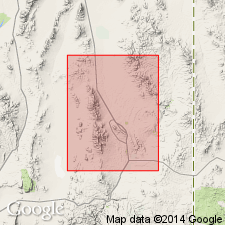
- Usage in publication:
-
- Ely Springs dolomite*
- Modifications:
-
- Named
- Dominant lithology:
-
- Dolomite
- Limestone
- AAPG geologic province:
-
- Great Basin province
Summary:
Named for exposures in Ely Springs Range. Dolomite or dolomitic limestone, usually dark gray dolomite weathering to smoky brown, in beds of variable thickness up to 5 ft. Is cherty at a number of levels. In upper part are some thick beds of gray dolomite. Total thickness is 675 ft. Age is Late Ordovician (Cincinnatian) based on fossils [brachiopods, trilobites] identified by E. Kirk.
Source: GNU records (USGS DDS-6; Menlo GNULEX).
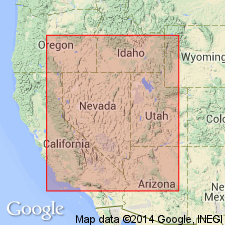
- Usage in publication:
-
- Ely Springs Dolostone
- Modifications:
-
- Revised
- Redescribed
- Overview
- Dominant lithology:
-
- Dolostone
- AAPG geologic province:
-
- Great Basin province
Summary:
Divided into four members which include, in ascending order, Ibex, Barn Hills, Lost Canyon, and Floride. Redescribed from dolomite, a mineral term, to dolostone, a rock term. Outcrops at several mountain ranges in western UT and eastern NV in Great Basin province. Overlies Eureka Quartzite; disconformably overlain by Laketown Dolostone (redescribed). Measured sections. Fossil corals indicate an early Late to late Late Ordovician age.
Source: GNU records (USGS DDS-6; Denver GNULEX).
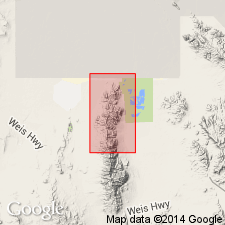
- Usage in publication:
-
- Ely Springs Dolomite*
- Modifications:
-
- Mapped 1:24k
- Revised
- AAPG geologic province:
-
- Great Basin province
Summary:
Divided into two members, an informal lower member and the upper Floride Member (rank reduced) in Fish Springs Range, Juab Co, UT, Great Basin province. Ely Springs overlies Eureka Quartzite; underlies [unconformably] Laketown Dolomite. Late Ordovician age.
Source: GNU records (USGS DDS-6; Denver GNULEX).
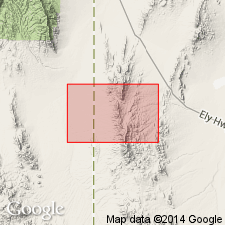
- Usage in publication:
-
- Ely Springs Dolomite*
- Modifications:
-
- Mapped 1:24k
- Dominant lithology:
-
- Dolomite
- AAPG geologic province:
-
- Great Basin province
Summary:
Is Upper Ordovician formation mapped in limited areas in the southeast corner of map area in the vicinity of The Needles in Beaver Co, southwest UT (Great Basin province). Is shown in subsurface in cross sections of southern Mountain Home Range in western Millard and Beaver Cos, southwest UT. Overlies Eureka Quartzite (Middle Ordovician). Unconformably overlain by Laketown Dolomite (Middle Silurian). Map unit described as dark-brownish-gray, cherty, unfossiliferous, ledge- and cliff-forming dolomite. About 100 m thick.
Source: GNU records (USGS DDS-6; Denver GNULEX).
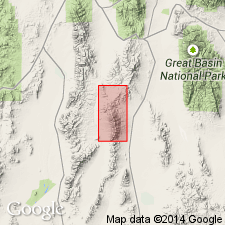
- Usage in publication:
-
- Ely Springs Dolostone*
- Modifications:
-
- Mapped 1:50k
- Redescribed
- Dominant lithology:
-
- Dolostone
- AAPG geologic province:
-
- Great Basin province
Summary:
Redescribed on basis of change in lithic designation from dolomite to dolostone (more appropriate term). Is mapped undivided with overlying Laketown Dolostone (Middle and Upper Silurian) in northeastern part of study area, Lincoln and White Pine Cos, NV in east-central part of Great Basin province. Complex structure, poor exposures, and similarities between Ely Springs and Laketown Dolostones preclude any separation locally. Ely Springs is brown-weathering, medium- to dark-gray, fine-grained dolostone that contains horn corals and gastropods. Good exposures in southeastern part of study area suggest it is disconformable on Eureka Quartzite (Middle Ordovician). Only lower part is present. Thickness in Egan Range (to west) is about 500 ft (Kellogg, 1963, p. 685). Age is Late Ordovician.
Source: GNU records (USGS DDS-6; Denver GNULEX).
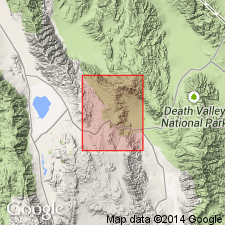
- Usage in publication:
-
- Ely Springs Limestone*
- Modifications:
-
- Revised
- Age modified
- AAPG geologic province:
-
- Great Basin province
Summary:
Unit is redefined as the Ely Springs Limestone and geographically extended into the Talc City Hills, Inyo Co, CA. Age is Late Ordovician and Early Silurian in the Talc City Hills on the basis of fossils [conodonts]. Overall age of unit is extended from Middle Ordovician to Early Silurian.
Source: GNU records (USGS DDS-6; Menlo GNULEX).
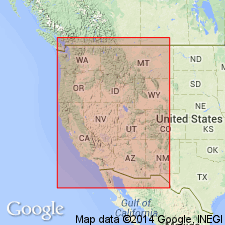
- Usage in publication:
-
- Ely Springs Dolostone*
- Modifications:
-
- Redescribed
- Overview
- Dominant lithology:
-
- Dolostone
- AAPG geologic province:
-
- Snake River basin
- Great Basin province
Summary:
Is redescribed as dolostone. The name "dolostone" is used for rocks composed predominantly of the mineral "dolomite" on Figure 2 and throughout this chapter, although in the literature it has been common practice to use dolomite rather than dolostone in formal names of dolomitic formations and members. Occurs in stratigraphic column for central ID (Snake River basin); unconformably above Kinnikinic Quartzite (Middle Ordovician); conformably below unnamed Lower Silurian dolostone. In stratigraphic column for east-central CA (Great Basin province); unconformably above Johnson Spring Formation (Middle Ordovician); unconformably below unnamed Lower Silurian dolostone. In stratigraphic column for east-central NV (Great Basin province); unconformably above Eureka Quartzite (Middle Ordovician); unconformably below Laketown Dolostone (redescribed) (Lower Silurian). In stratigraphic column for west-central UT (Great Basin province); unconformably above Eureka Quartzite; unconformably below Laketown Dolostone. In stratigraphic column for southeast CA (Great Basin province); unconformably above Eureka Quartzite; unconformably below Hidden Valley Dolostone (redescribed) (Silurian and Lower Devonian). Assigned to Cincinnatian Series (Upper Ordovician) and Llandoverian (Lower Silurian).
Source: GNU records (USGS DDS-6; Denver GNULEX).
For more information, please contact Nancy Stamm, Geologic Names Committee Secretary.
Asterisk (*) indicates published by U.S. Geological Survey authors.
"No current usage" (†) implies that a name has been abandoned or has fallen into disuse. Former usage and, if known, replacement name given in parentheses ( ).
Slash (/) indicates name conflicts with nomenclatural guidelines (CSN, 1933; ACSN, 1961, 1970; NACSN, 1983, 2005, 2021). May be explained within brackets ([ ]).

